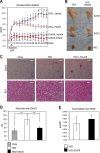Selective inhibition of hypoxia-inducible factor 1α ameliorates adipose tissue dysfunction
- PMID: 23249949
- PMCID: PMC3623075
- DOI: 10.1128/MCB.00951-12
Selective inhibition of hypoxia-inducible factor 1α ameliorates adipose tissue dysfunction
Abstract
Hypoxia-inducible factor 1α (HIF1α) induction in adipocytes is a critical component of the "fibrotic response," directly linked to metabolic dysfunction in adipose tissues under hypoxic conditions. We reasoned that inhibition of HIF1α may ameliorate the negative aspects of the obesity-associated fat pad expansion. We used the selective HIF1α inhibitor PX-478, whose effectiveness has previously been established in tumor models. We demonstrate that PX-478 treatment effectively suppresses the high-fat-diet (HFD)-induced HIF1α activation in adipose tissue. HIF1α inhibition causes a reduction of weight gain in mice on an HFD but not on a chow diet. Treatment increases energy expenditure and prompts resistance to HFD-mediated deterioration of metabolic parameters. Moreover, PX-478-treated mice have reduced fibrosis and fewer inflammatory infiltrates in their adipose tissues. We confirm the metabolic effects obtained with PX-478 treatment using an adipose tissue-specific, doxycycline-inducible dominant negative HIF1α mutant (dn-HIF1α). Consistent with the pharmacological results, genetic inhibition of endogenous HIF1α activity prompts similar metabolic improvements in HFD-fed mice. Collectively, our results demonstrate that HIF1α inhibition in the adipocyte leads to significant metabolic improvements, suggesting that selective HIF1α inhibition in adipose tissue may be an effective therapeutic avenue in the context of metabolic dysfunction.
Figures








Similar articles
-
Serpina3c deficiency promotes obesity-related hypertriglyceridemia and inflammation through activation of the Hif1α-glycolysis axis in adipose tissue.Clin Sci (Lond). 2025 Aug 29;139(16):897-918. doi: 10.1042/CS20242610. Clin Sci (Lond). 2025. PMID: 39693610
-
Disruption of hypoxia-inducible factor 1 in adipocytes improves insulin sensitivity and decreases adiposity in high-fat diet-fed mice.Diabetes. 2011 Oct;60(10):2484-95. doi: 10.2337/db11-0174. Epub 2011 Aug 26. Diabetes. 2011. PMID: 21873554 Free PMC article.
-
Adipose tissue-specific inhibition of hypoxia-inducible factor 1{alpha} induces obesity and glucose intolerance by impeding energy expenditure in mice.J Biol Chem. 2010 Oct 22;285(43):32869-32877. doi: 10.1074/jbc.M110.135509. Epub 2010 Aug 16. J Biol Chem. 2010. PMID: 20716529 Free PMC article.
-
Fibrosis and adipose tissue dysfunction.Cell Metab. 2013 Oct 1;18(4):470-7. doi: 10.1016/j.cmet.2013.06.016. Epub 2013 Aug 15. Cell Metab. 2013. PMID: 23954640 Free PMC article. Review.
-
Adipose Tissue Dysfunction Following Trauma and Hypoxia Increases the Risk of Post-Surgical Adhesion: Potential for Therapeutic Interventions.Curr Mol Pharmacol. 2024;17:e18761429308567. doi: 10.2174/0118761429308567240806111848. Curr Mol Pharmacol. 2024. PMID: 39143882 Review.
Cited by
-
Fibrosis in fat: From other diseases to Crohn's disease.Front Immunol. 2022 Aug 25;13:935275. doi: 10.3389/fimmu.2022.935275. eCollection 2022. Front Immunol. 2022. PMID: 36091035 Free PMC article. Review.
-
Hypoxia-inducible factor prolyl hydroxylase 1 (PHD1) deficiency promotes hepatic steatosis and liver-specific insulin resistance in mice.Sci Rep. 2016 Apr 20;6:24618. doi: 10.1038/srep24618. Sci Rep. 2016. PMID: 27094951 Free PMC article.
-
Hypoxia inducible factor 1α inhibitor PX-478 reduces atherosclerosis in mice.Atherosclerosis. 2022 Mar;344:20-30. doi: 10.1016/j.atherosclerosis.2022.01.002. Epub 2022 Jan 21. Atherosclerosis. 2022. PMID: 35121387 Free PMC article.
-
EGR1 Transcription Factor is a Multifaceted Regulator of Matrix Production in Tendons and Other Connective Tissues.Int J Mol Sci. 2020 Feb 28;21(5):1664. doi: 10.3390/ijms21051664. Int J Mol Sci. 2020. PMID: 32121305 Free PMC article. Review.
-
Tumor Hypoxia As an Enhancer of Inflammation-Mediated Metastasis: Emerging Therapeutic Strategies.Target Oncol. 2018 Apr;13(2):157-173. doi: 10.1007/s11523-018-0555-4. Target Oncol. 2018. PMID: 29423593 Review.
References
-
- Weyer C, Foley JE, Bogardus C, Tataranni PA, Pratley RE. 2000. Enlarged subcutaneous abdominal adipocyte size, but not obesity itself, predicts type II diabetes independent of insulin resistance. Diabetologia 43: 1498–1506 - PubMed
-
- Hosogai N, Fukuhara A, Oshima K, Miyata Y, Tanaka S, Segawa K, Furukawa S, Tochino Y, Komuro R, Matsuda M, Shimomura I. 2007. Adipose tissue hypoxia in obesity and its impact on adipocytokine dysregulation. Diabetes 56: 901–911 - PubMed
Publication types
MeSH terms
Substances
Grants and funding
LinkOut - more resources
Full Text Sources
Other Literature Sources
Molecular Biology Databases
